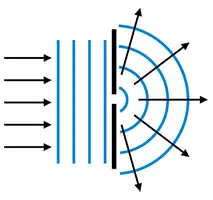 The etymology of diffraction refers us to diffractus , a term that can be translated as "broken" . This concept is used in the field of physics to name the deflection of a wave when it passes through an opening or hits the edge of an opaque element .
The etymology of diffraction refers us to diffractus , a term that can be translated as "broken" . This concept is used in the field of physics to name the deflection of a wave when it passes through an opening or hits the edge of an opaque element .
Diffraction is a phenomenon that involves all waves : electromagnetic, radio, sound, etc., and it is possible to predict its development using different mathematical approaches. When the wave passes through a crack or encounters an obstacle, it is deflected.
There is an analysis method called Huygens' principle , which allows us to understand diffraction as a wave front that is seen as a series of emitters capable of redirecting the wave when it oscillates and in this way promoting its propagation. Although the waves produced by the oscillators are spherical, their interference causes a plane wave that moves in the same direction as the initial one.
Near-field diffraction , also known as Fresnel (after Augustin-Jean Fresnel , a French physicist born in 1788 and died in 1827), is a diffraction pattern of those electromagnetic waves that are obtained in the vicinity of the element that causes the phenomenon itself, which is usually an opening or a fountain.
In the field of optics, the branch of physics that is dedicated to studying the properties and behavior of light, a perforation or hole through which light passes is known as an aperture . In more specific terms, it is the determining factor of the angle of the cone of the ray beam that will be focused in the plane.
Another of the concepts that is key to understanding and calculating near field diffraction is the Fresnel number , another of the contributions of the respected French physicist. It is a number that is not defined by physical units (that is, a dimensionless or pure number), used in the field of optics and defined by the following equation: Aperture squared / Distance between the aperture and the screen x Wavelength.
That of the far field or Fraunhofer , on the other hand, is oriented to a wave whose source and its screen are very far from the obstacle that causes the diffraction, so that plane waves (also called monodimensional waves, are constant and their wave fronts are parallel and normal to the phase velocity).
 It is correct to say that far-field diffraction is a particular case of the previous one. Its analysis is easier, since the distance between the aperture and the screen is considerable and it is possible to study the rays in parallel, something that does not happen with near-field diffraction.
It is correct to say that far-field diffraction is a particular case of the previous one. Its analysis is easier, since the distance between the aperture and the screen is considerable and it is possible to study the rays in parallel, something that does not happen with near-field diffraction.
Thanks to the use of the Fresnel number it is possible to know which of the two types of diffraction we are dealing with: when its value is much less than unity, the present phenomenon is far field diffraction, and vice versa.
The phenomenon of diffraction is applied in different types of studies and research. The so-called X-ray crystallography is based on diffraction to analyze materials with a periodic structure, such as crystals . This technique was very important in the study of the structure of DNA , for example.
In this case, the X-rays undergo diffraction due to the electrons that are surrounding the atoms of the crystal. The beam that emerges from this encounter contains data on the types of atoms and their positions. This information is observed and measured through different detectors.
